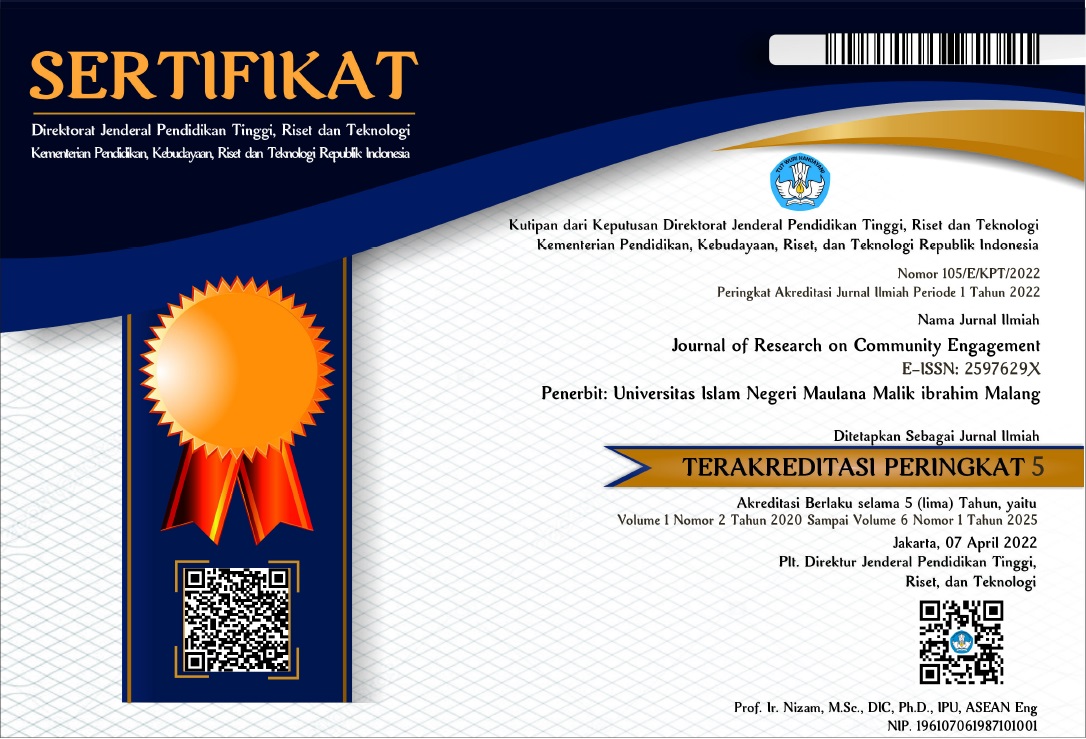Pendampingan Anggota Igra dalam Melaksanakan Proses Belajar Mengajar Kreatif dan Menyenangkan Berbasis Konten Kreator
Abstract
Education is an effective way to combat poverty, with teachers playing key roles as facilitators, motivators, and guides in the learning process. In early childhood education, particularly in Raudhatul Athfal (RA), teachers play a crucial role in instilling values of faith, independence, and good moral character in children during their golden age (0-5 years old). This research aims to empower RA teachers in Kecamatan Turen to create social media-based learning content as an innovative method to enhance student engagement.
The research method employed is Participatory Action Research (PAR), involving 13 RA institutions in Kecamatan Turen, with a focus on training teachers to produce digital learning content. The findings reveal that most teachers already use digital tools in teaching, but there are still challenges in developing digital content that aligns with the cognitive development of young children. Additionally, the study emphasizes the importance of creating official social media accounts and websites for each RA, integrated into a unified platform at the district level.
The outcomes of this program are expected to enhance teachers' abilities in utilizing social media as an interactive and engaging learning tool. Thus, empowering teachers to create educational digital content is key to improving the quality of education, especially for early childhood. Continuous evaluation through feedback allows for the refinement of teaching methods, fostering a more effective and creative learning environment.Full Text:
PDFReferences
[1] I. D. Palupi, "Pengaruh Media Sosial pada Perkembangan Kecerdasan Anak Usia Dini," Jurnal Edukasi Nonformal, vol. 1, pp. 127-134, 4 Maret 2020.
[2] Kementerian Kesehatan, "https://yankes.kemkes.go.id/," 23 Agustus 2024. [Online]. Available: Kemenkes 2024: https://yankes.kemkes.go.id/view_artikel/2713/optimalkan-golden-age-anak-untuk-generasi-bebas-stunting. [Accessed Maret 2024].
[3] BPS Kecamatan Turen, "BPS Kecamatan Turen dalam Angka," Januari 2021. [Online]. Available: https://malangkab.bps.go.id/publication/download.html?nrbvfeve=ZTRkZmRmM2NiYWVkZjgwNTdlNTE3Zjhk&xzmn=aHR0cHM6Ly9tYWxhbmdrYWIuYnBzLmdvLmlkL3B1YmxpY2F0aW9uLzIwMjIvMDkvMjYvZTRkZmRmM2NiYWVkZjgwNTdlNTE3ZjhkL2tlY2FtYXRhbi10dXJlbi1kYWxhbS1hbmdrYS0yMDIyLmh0bWw%3D. [Accessed Maret 2023].
[4] S. Kindon, R. Pain, and M. Kesby, Participatory Action Research Approaches and Methods Connecting People, Participation and Place, I. 9780415599764, Ed., Madison Avenue: Routldge: Taylor& Francis Group, 20027.
[5] L. T. Smith, Decolonizing Methodologies Research and Indigenous Peoples, London and New York: Zen Book Ltd: University of Otago Press, 2008.
[6] F. Cornish, N. Breton and U. M. Tabarez, "Participatory action research," Nature Reviews Methods Primers, vol. 3, no. 34, pp. https://doi.org/10.1038/s43586-023-00214-1, 2023.
[7] P. Reason and H. Bradbury, "The SAGE handbook of action research: Participative inquiry and practice," in The SAGE handbook of action research, London, SAGE Publication, 2008.
DOI: https://doi.org/10.18860/jrce.v6i1.29118
Refbacks
- There are currently no refbacks.
Copyright (c) 2024 Ria Dhea Layla Nur Karisma, HAWZAH SA'ADATI, Muhammad Khudzaifah, Dewi Ismiarti

This work is licensed under a Creative Commons Attribution-ShareAlike 4.0 International License.




.jpg)